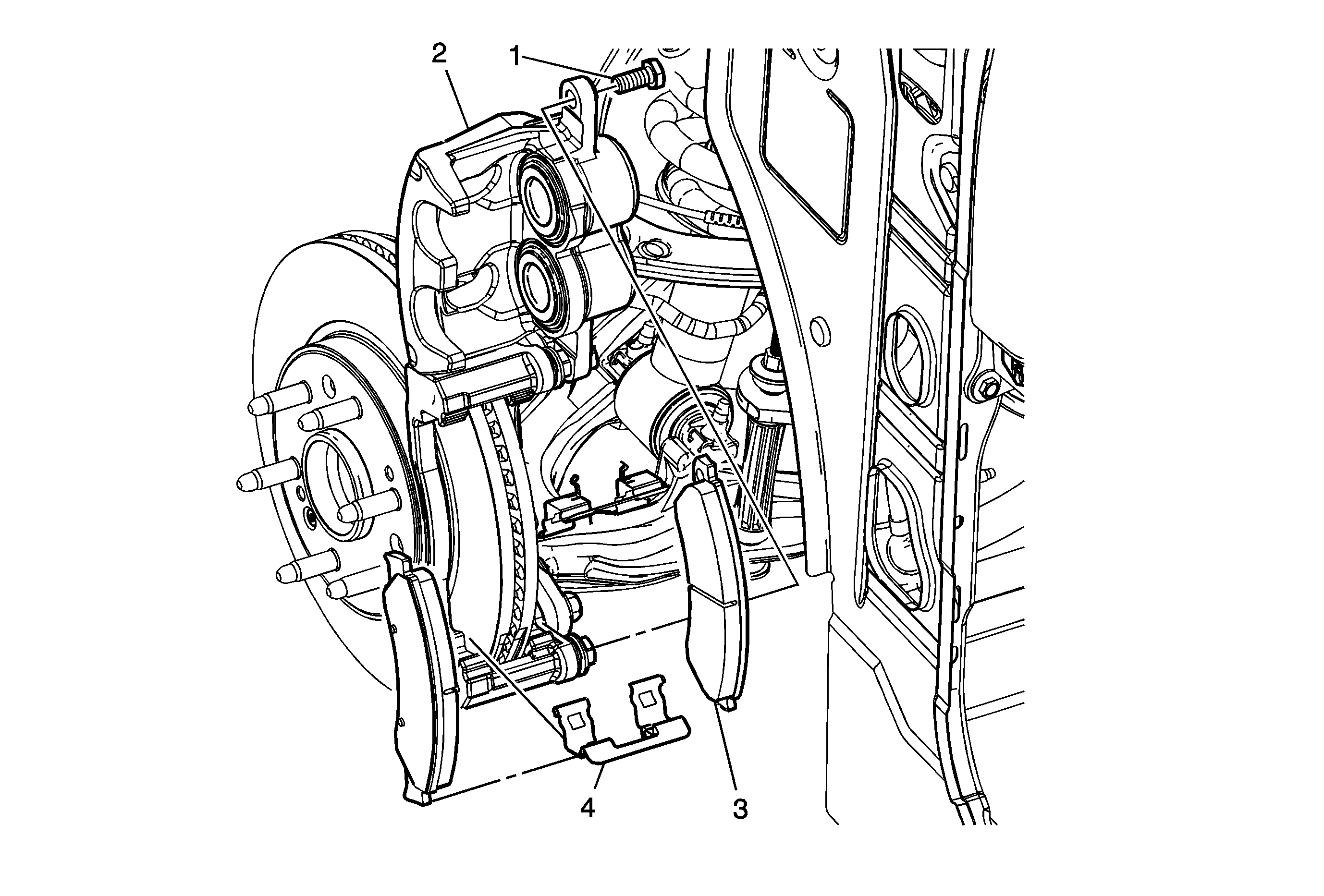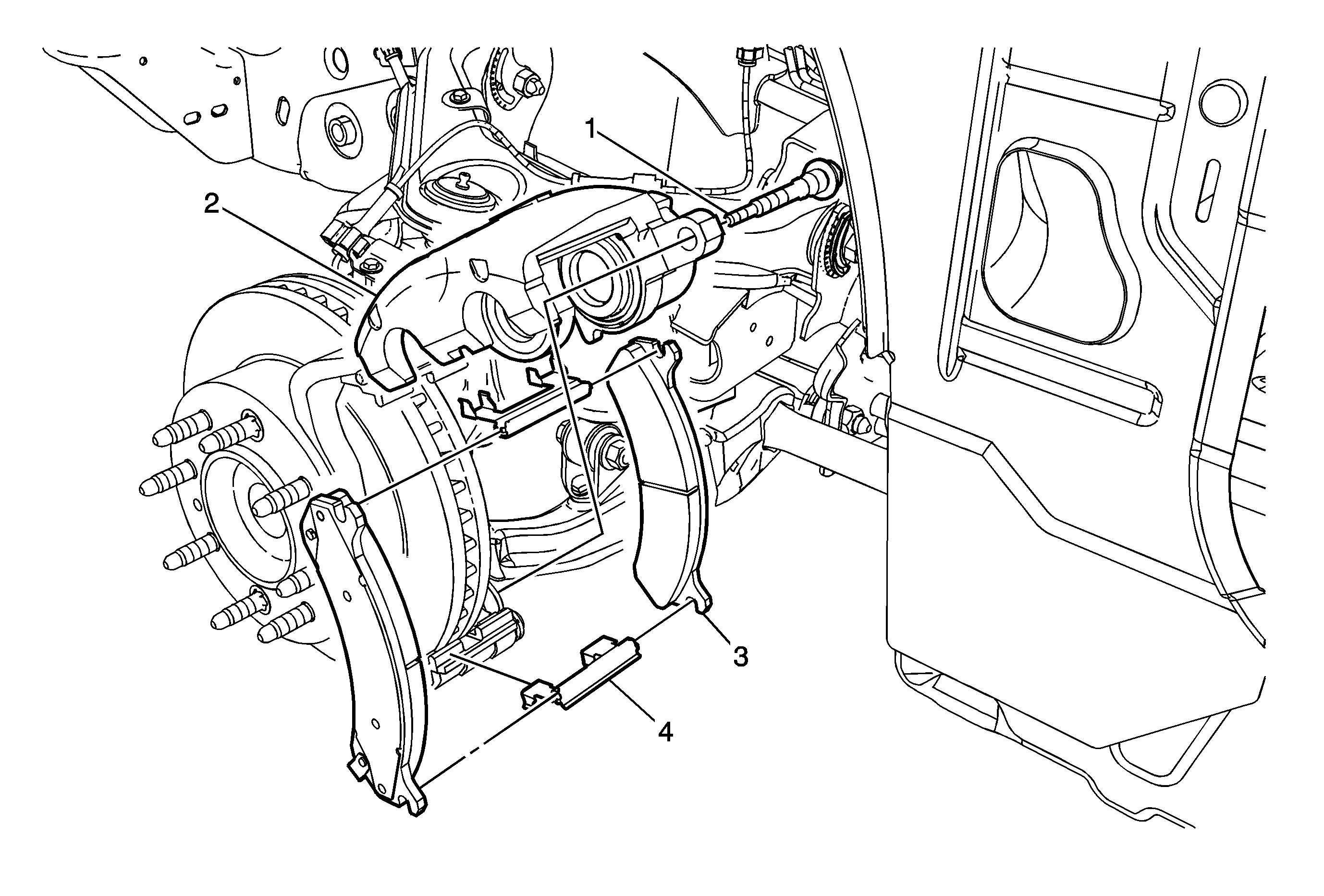Callout
| Component Name
|
|
Warning: Refer to Brake Dust Warning in the Preface section.
Caution: Support the brake caliper with heavy mechanic wire, or equivalent, whenever it is separated from its mount and the hydraulic flexible brake hose is still connected. Failure to support the caliper
in this manner will cause the flexible brake hose to bear the weight of the caliper, which may cause damage to the brake hose and in turn may cause a brake fluid leak.
Preliminary Procedures
- Inspect the fluid level in the brake master cylinder reservoir.
- If the brake fluid level is midway between the maximum-full point and the minimum allowable level, no brake fluid needs to be removed before proceeding.
- If the brake fluid level is higher than midway between the maximum-full point and the minimum allowable level, remove brake fluid to the midway point before proceeding.
- Raise and support the vehicle. Refer to
Lifting and Jacking the Vehicle.
- Remove the tire and wheel assembly. Refer to
Tire and Wheel Removal and Installation.
|
1
| Brake Caliper Guide Pin Bolt
Caution: Refer to Fastener Caution in the Preface section.
Procedure
- DO NOT use any air tools to remove or install the brake caliper guide pin bolts. Use hand tools ONLY.
- Install an open end wrench to hold the caliper guide pin in line with the brake caliper while removing or installing the caliper guide pin bolts. DO NOT allow the open end wrench to contact the brake caliper. Allowing the open end wrench to contact
the brake caliper will cause a pulsation when the brakes are applied.
- Ensure the brake caliper guide pin seal is fully seated in the groove of the brake caliper guide pin and the guide pin slides freely in caliper bracket bore.
Tighten
100 N·m (74 lb ft) |
2
| Brake Caliper
Procedure
- Install 2 large C-clamps over the top of the caliper housing and against the back of the outboard brake pad.
- Slowly and evenly tighten the C-clamps until the caliper pistons are completely retracted into the brake caliper bores.
- Remove the C-clamps.
- Without disconnecting the brake hose, pivot the brake caliper upward.
- Support the brake caliper with heavy mechanics wire or equivalent.
- If installing the original brake pads, thoroughly clean the brake caliper piston faces and caliper to brake pad contact surfaces of all disc brake pad insulator adhesive residue with denatured alcohol and allow to dry.
Use care to avoid
damaging the brake caliper piston dust seals.
|
3
| Disc Brake Pad (Qty: 2)
Procedure
- If installing the original brake pads, note the location of the brake pads for proper installation.
- If installing new brake pads, remove the backing paper from the brake pad insulators.
|
4
| Brake Pad Shim (Qty: 2)
Procedure
- Discard the brake pad shims.
- Thoroughly clean the brake pad hardware mating surfaces of the caliper bracket of any debris and corrosion.
- Apply a very thin coating of high temperature silicone brake lubricant to the pad hardware mating surfaces of the caliper bracket only.
- After the installation is complete and with the engine OFF, gradually apply the brake pedal to approximately 2/3 of its travel distance.
- Slowly release the brake pedal.
- Wait 15 seconds, then repeat steps 4-5 until a firm brake pedal is obtained. This will properly seat the brake caliper pistons and brake pads.
- Fill the master cylinder to the proper level. Refer to
Master Cylinder Reservoir Filling.
- Firmly apply and maintain pressure on the brake pedal for 30 seconds to seat the brake pad insulators to the brake caliper pistons and brake caliper housing.
- Burnish the brake pads and rotors. Refer to
Brake Pad and Rotor Burnishing.
|
Callout
| Component Name
|
|
Warning: Refer to Brake Dust Warning in the Preface section.
Caution: Support the brake caliper with heavy mechanic wire, or equivalent, whenever it is separated from its mount and the hydraulic flexible brake hose is still connected. Failure to support the caliper
in this manner will cause the flexible brake hose to bear the weight of the caliper, which may cause damage to the brake hose and in turn may cause a brake fluid leak.
Preliminary Procedures
- Inspect the fluid level in the brake master cylinder reservoir.
- If the brake fluid level is midway between the maximum-full point and the minimum allowable level, no brake fluid needs to be removed before proceeding.
- If the brake fluid level is higher than midway between the maximum-full point and the minimum allowable level, remove brake fluid to the midway point before proceeding.
- Raise and support the vehicle. Refer to
Lifting and Jacking the Vehicle.
- Remove the tire and wheel assembly. Refer to
Tire and Wheel Removal and Installation.
|
1
| Brake Caliper Guide Pin Bolt
Caution: Refer to Fastener Caution in the Preface section.
Tighten
108 N·m (80 lb ft) |
2
| Brake Caliper
Procedure
- Install 2 large C-clamps over the top of the caliper housing and against the back of the outboard brake pad.
- Slowly and evenly tighten the C-clamps until the caliper pistons are completely retracted into the brake caliper bores.
- Remove the C-clamps.
- Without disconnecting the brake hose, pivot the brake caliper upward.
- Support the brake caliper with heavy mechanics wire or equivalent.
|
3
| Disc Brake Pad (Qty: 2)
Tip
Note the location of the inner and outer brake pads to aid installation. |
4
| Brake Pad Shim (Qty: 2)
Procedure
- Discard the brake pad shims.
- Thoroughly clean the brake pad hardware mating surfaces of the caliper bracket of any debris and corrosion.
- After the installation is complete and with the engine OFF, gradually apply the brake pedal to approximately 2/3 of its travel distance.
- Slowly release the brake pedal.
- Wait 15 seconds, then repeat steps 3-4 until a firm brake pedal is obtained. This will properly seat the brake caliper pistons and brake pads.
- Fill the master cylinder to the proper level. Refer to
Master Cylinder Reservoir Filling.
- Burnish the brake pads and rotors. Refer to
Brake Pad and Rotor Burnishing.
|


